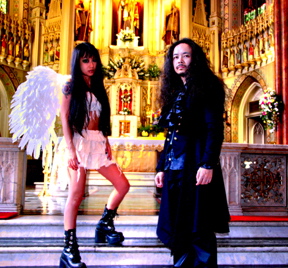Artist: Sigh
Album: In Somniphobia
It may be me showing my age, but I choose never to hang my reviews on your assumed knowledge of today’s fragmented genres. For one thing, the huge, goofy grins I get playing Sigh‘s In Somniphobia have nothing to do with, e.g., All Music Guide’s claim that Sigh began in 1993 as a founder of Japanese black metal with thrash leanings, then evolved towards extreme  metal with avant-garde leanings. But even if that description did feel true, I’d want to start you somewhere more familiar, part of shared culture.
metal with avant-garde leanings. But even if that description did feel true, I’d want to start you somewhere more familiar, part of shared culture.
For Sigh, to me, that’s easy. Thirty years ago, anyone who cared to could keep up with heavy-metal, and millions did: it sounded triumphant, like Deep Purple, Judas Priest, Iron Maiden, Van Halen (wagging their dicks to Eddie’s glorious pseudo-classical riffs), and Andrew Lloyd Webber’s Cats (uh, work with me on this one, k?). Sigh play faster, have a better/ fiercer drummer (Junichi Harashima), and replace the singers with grunting trolls. But they also take those old tropes, and infuse them with endless cascades of melody. Despite the vocals, In Somniphobia is the most tuneful heavy metal album I’ve heard — and quite possibly, despite lyrics about enslavement and eternal torment and “nocturnal visions invad[ing] my sanity”, the most joyous. If Ludwig van Beethoven had composed his symphonies for modern metal bands, Sigh would get the parts marked “vivace” and “allegro con brio”.
The most traditional circa-1980 riffs and solos here are on Purgatorium, the Transfiguration Fear, and Fall to the Thrall. The textures behind the loud guitar-/bass/drums are varied, though. Purgatorium has violin, elegant enough to play for customers at fancy restaurants; sprinklings of piano; and organ fanfare. Transfiguration Fear features hand-drums, hand-claps, spooky theremin whistling, female Viking backup singers, and a poppy saxophone solo by full-time band member Dr. Mikannibal. Fall to the Thrall also has thrashy Metallica Master of Puppets-style sections, but balances them with passages of romantic lead piano for the guitars to play shiny tunes alongside.
Stuff like that would already avoid metal’s most frequent failing for me, the part where a band’s songs blend together (an issue even Sigh faced on my prior exposure to them, the darker, heavier, and otherwise quite impressive Scenes from Hell (’10)). But those songs understate how many tricks Sigh have mastered. Somniphobia‘s riffs are meaner, more angular, elevated by singing orcs and hints of saxophone squall, before breaking into a slow-dance for Mexican robots and airport P.A. announcers. L’Excommunication a Minuit has a pulse-racing propulsion that reminds me the “Mission Impossible” theme, peppy sax, and cackling birds. Far Beneath the In-Between, in 3/4 time, is truly dark and howling for much of its length, but can’t resist a glorious melodic refrain that feels like a bar mitzvah band after the part where all the adults have had time to get drunk. (Assuming the adults are old-time Jewish dwarf miner/ warriors, sure.) Amnesia, also in 3/4 time with lots of sax and piano, would be sexy-time music in a movie, at least the kind of movie where the sex scene is intercut with the gathering outside the building of the specialist-team hunting for (or planting) explosives. Amongst the Phantoms of Abandoned Tumbrils — dusky and dramatic, soaring with bells and synth-birdcalls when a lift is needed, with too a decent synthesizer replacement for harmonica — would be perfect for improving for the 55% of Peter Jackson’s “Lord of the Rings” movie trilogy that’s long, long, long shots of characters walking. Equale doesn’t sound to me like Deep Purple, Sting, Dire Straits, and Slayer jamming together with a harpsichordist on variations from baroque sheet music, but only because — as I don’t think that collaboration would — it flows smoothly, like the most obvious thing in the world.
I review Sigh as a heavy-metal fan (although less of one than my 2012 countdown must imply; 2012 was, for me, an *amazing* year for the genre). Heavy metal fandom is certainly useful for appreciating it: the riffs, the gleaming solos, the blastbeat drums. It’s useful for accepting the shredded vocal croaking as amusingly beside-the-point, for hearing the giddiness in routine lyrics like “Bring out your dead withered skin/ Bring out your dead languid limbs”. Maybe it’s even helpful for appreciating the basic stupid joy of, on separate songs, “I live! You die!”, “You will die tonight!”, “Your fate is on fire, the trap behind you!”, and — for variety — “Kill me now!”.
But I’m not kidding about Beethoven. In Somniphobia is a huge burst of melody-driven expressionism. It’s a burst that at least seems informed by the classics. Ludwig didn’t live to experience electricity, amplifiers, distortion pedals; he put his grooming into powdered wigs instead of flowing, chest-length natural hair dyed Manic Panic yellow. I think the poor guy missed out. And I think it’s at least 50/50 that he’d agree with me.
– Brian Block
To see the rest of our favorites, visit our Favorite Albums of 2012 page!
